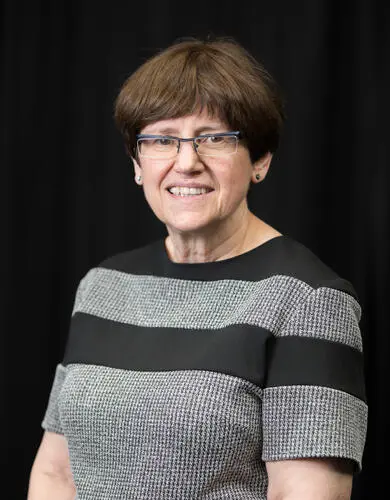An associate professor in the departments of Cardiac Sciences and Medicine at the University of Calgary's Cumming School of Medicine, Kavanagh is a researcher and cardiologist specializing in electrophysiology, and was recently recognized with the 2025 Magdy Basta Award from the Canadian Heart Rhythm Society (CHRS).

Photo Credit: Libin Cardiovascular Institute
Named in honour of a longtime CHRS member, the award is given to an individual who has made great efforts to support the research of others through mentoring, clinical trials, research, education, grant assistance and more.
Kavanagh is the first female electrophysiologist to receive the award and says she is honoured to be recognized by her peers.
"Receiving the award was fantastic," Kavanagh says.
"It's extra special to have received the award in Halifax, both where I started my career and where Dr. Basta practised."
Professional journey from Newfoundland to Calgary to Edmonton
Kavanagh started her medical training in her home province of Newfoundland, earning her MD at Memorial University. Following her internship in Winnipeg, Kavanagh was a general practitioner at a Cottage Hospital in Newfoundland for three years.
It was a memorable time for Kavanagh, who quickly became part of the community as she cared for everyone from newborns to seniors.
Kavanagh returned to Memorial University for her internal medicine training and completed her cardiology training at Dalhousie University.
It was at Dalhousie that her interest in electrophysiology was sparked by the realities of patient care.
"When an arrhythmia patient came in, no one knew what to do with them," says Kavanagh, explaining that in the 1980s, there were few effective treatments.
"This was my reason for going into electrophysiology."
Kavanagh came to Calgary to study electrophysiology.
She was UCalgary's first electrophysiology fellow and studied under internationally recognized physician-researchers Dr. George Wyse, MD'74, PhD; Dr. Brent Mitchell, BSc'72, MD'75; and Dr. Hank Duff, MD.
At that time, electrophysiology was in its infancy, and the only device available for treatment was a large defibrillator that required open-chest surgery to place patches on the heart and the generator was placed under the skin in the abdomen.
Kavanagh began doing research into electrical therapies, pacing and defibrillation in the UCalgary lab of Dr. Wayne Giles, PhD.
There weren't a lot of women in the lab in those days, but Kavanagh soon won over her colleagues with her quiet determination and friendly personality.
She completed a research fellowship at Duke University before joining the University of Alberta as an assistant professor in 1990.
Part of her research at UAlberta involved a collaboration with Dr. Derek Exner, MD, of UCalgary. The REFINE cohort study aimed to identify patients most at risk of developing a heart-rhythm disorder, which can be fatal.
"Our goal was to find markers and identifiers for patients who have had a heart attack and who were likely to benefit from treatment," says Kavanagh.
"It was a pretty important study."
The study found that certain markers T-wave alternans and turbulence can help identify patients with moderate heart damage, who are most at risk of developing a life-threatening heart-rhythm disturbance.
Return to Calgary to lead REFINE study
In 2004, Kavanagh was recruited to UCalgary, where she continued both her clinical and research work.
Still collaborating with Exner, Kavanagh was the local lead for REFINE ICD, a multi-site international study based at UCalgary. The long-term study (2011-2024) looked at the impact of an implantable cardioverter-defibrillator (ICD) a device with leads in the heart and a generator implanted under the skin to monitor the heart and deliver electric shocks to correct life-threatening rapid heart rhythms in patients they had identified as being at high risk for a life-threatening arrhythmia.
Results from that study will be published in the coming months.
Kavanagh also served as the Electrophysiology Fellowship director at UCalgary from 2004-2011, stepping down to take over the role of cardiology training director in 2011, a position she held until 2024. Kavanagh was chair of the Royal College of Physicians and Surgeons of Canada AFC (Area of Focused Competence) subcommittee for electrophysiology and was responsible for shepherding the Royal College program for UCalgary. She also served as a Royal College examiner for cardiology.
Working with young physicians has been one of the most fulfilling aspects of her career.
"One of the most fantastic things is to see these students go on and be successful," says Kavanagh. "It is a tremendous sense of accomplishment."
Challenges of entering a male-dominated field
She faced challenges in entering a traditionally male-dominated field.
"Electrophysiologist women were as scarce as hen's teeth," Kavanagh says of her early career, adding that balancing a busy career and life wasn't always easy.
While still in Edmonton, Kavanagh's husband began studying architecture in Calgary, leaving the young mom with the day-to-day responsibilities of raising their daughter, such as bringing her daughter to work when called in after hours and for 7 a.m. division meetings.
As Kavanagh makes her way closer to retirement, she offers the following advice to other young women hoping to follow her path.
"We need more female cardiologists and electrophysiologists," says Kavanagh, noting that women represent only about 23 per cent of those working in these professions in Canada.
"But it's a field you definitely have to love."
As for Kavanagh, she wouldn't change a thing about her path.
"From growing up while working at the Cottage Hospital, to my career as a researcher and clinician, I loved every part of it," she says.













